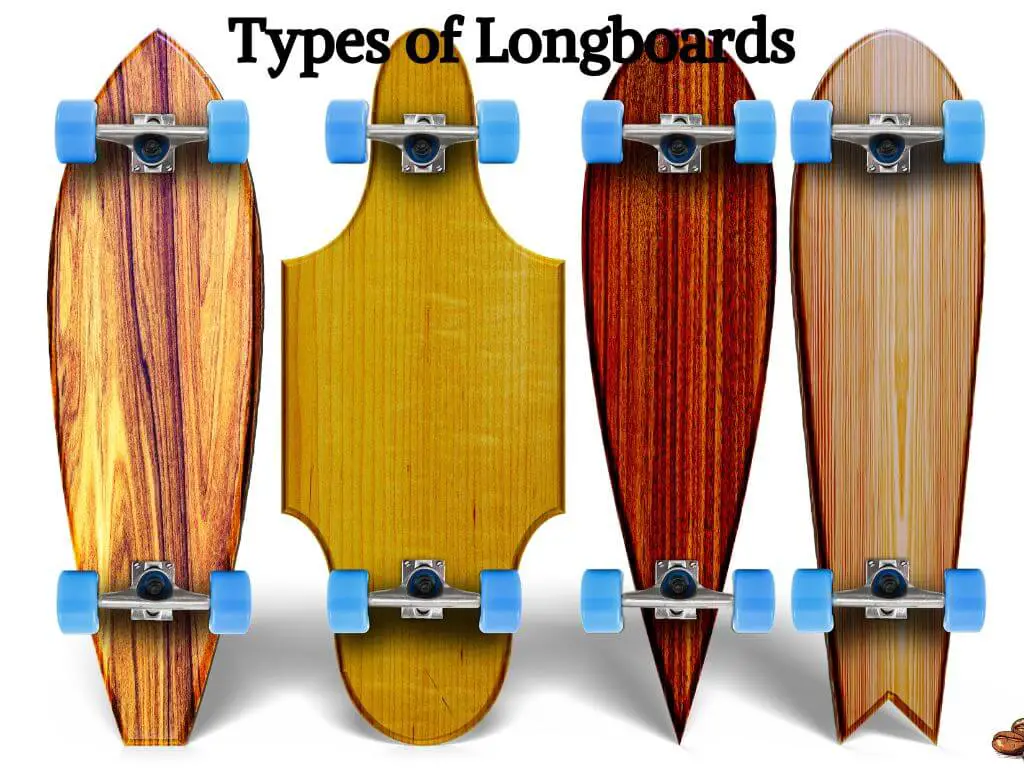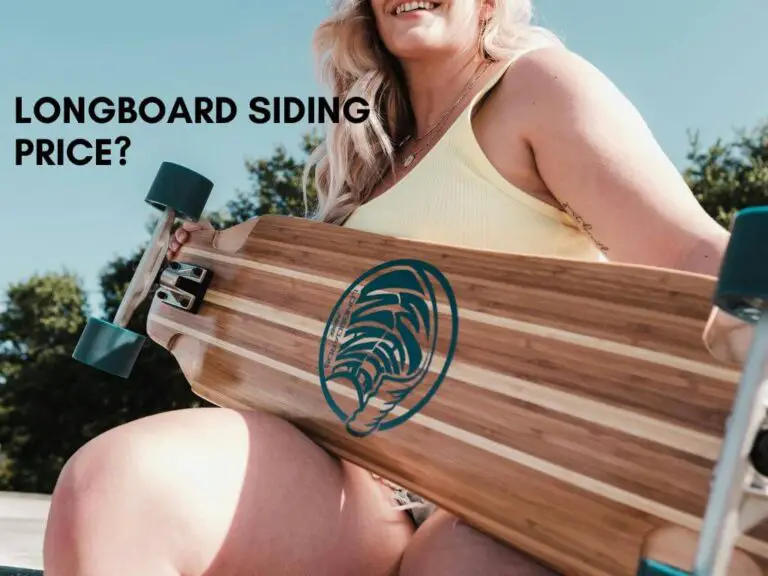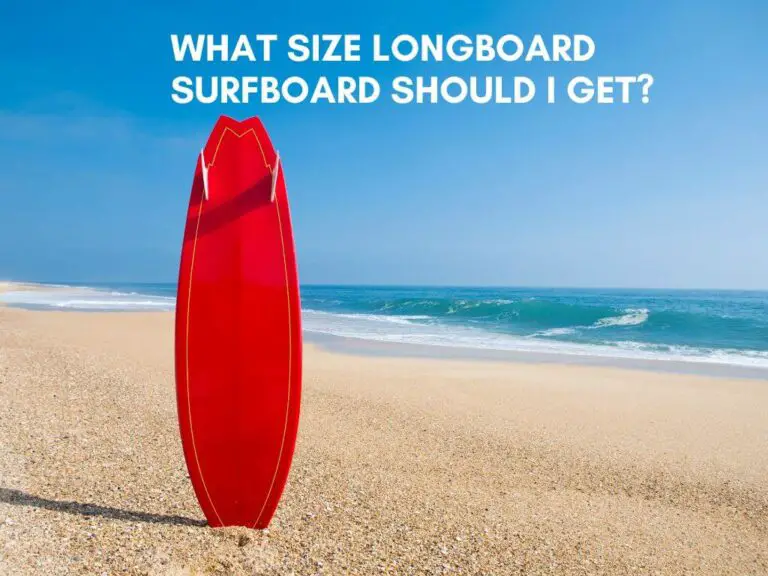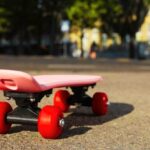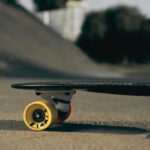Are you ready to dive into the thrilling world of longboarding? 🛹 Whether you’re a seasoned rider or a curious newbie, understanding the different types of longboards is crucial to finding your perfect ride. But with so many options out there, how do you know which one is right for you?
Imagine cruising down a beachside promenade, carving through winding mountain roads, or even dancing on your board as you glide along. Each of these experiences is made possible by a specific type of longboard designed for that purpose. From the laid-back cruiser to the adrenaline-pumping downhill board, there’s a longboard out there waiting to match your style and ambitions.
In this guide, we’ll take you on a journey through the six main types of longboards: cruising, downhill, freeride, carving, dancing, and electric. You’ll discover the unique features and benefits of each, helping you make an informed decision on which board will be your perfect companion for the ride ahead. So, buckle up (or should we say, strap on your helmet) as we roll into the exciting world of longboard varieties!
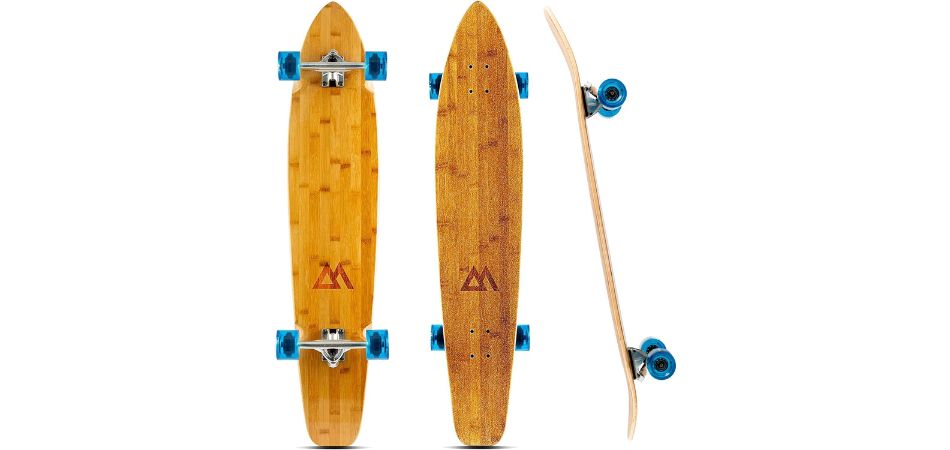
Cruising Longboards
When you’re looking for a relaxed and enjoyable longboarding experience, cruising longboards are your go-to choice. These versatile boards are designed to provide you with smooth rides, making them perfect for both leisure and transportation purposes.
Smooth Rides for Leisure and Transportation
Cruising longboards offer you a comfortable and effortless ride, allowing you to glide through city streets or beachside promenades with ease. The larger wheels and flexible deck absorb vibrations from rough surfaces, ensuring a smooth journey whether you’re out for a casual cruise or commuting to work or school.
Ideal for Beginners
If you’re new to longboarding, cruising boards are an excellent starting point. Their design prioritizes stability and ease of use, giving you the confidence to learn and improve your skills. The wider deck and softer wheels provide a forgiving platform that helps you maintain balance as you get accustomed to the riding experience.
Stable and Easy to Balance
One of the key features that make cruising longboards so appealing is their exceptional stability. The longer wheelbase and wider deck give you a solid foundation, reducing the likelihood of wobbles and enhancing your overall balance. This stability allows you to focus on enjoying the ride rather than worrying about staying upright.
Various Deck Shapes for Different Preferences
Cruising longboards come in a variety of deck shapes to suit your personal style and riding preferences. Here’s a comparison of some popular deck shapes:
| Deck Shape | Characteristics | Best For |
|---|---|---|
| Pintail | Narrow nose, wider tail | Smooth turns, classic look |
| Drop-through | Lowered deck, cutouts above trucks | Increased stability, easier pushing |
| Top-mount | Deck sits on top of trucks | More responsive turning, versatile |
| Drop deck | Lowered standing platform | Lower center of gravity, stable at speed |
When choosing a cruising longboard, consider factors such as your riding style, terrain, and personal comfort. The pintail shape offers a classic surfboard-inspired look and is great for smooth turns. If you prioritize stability and easy pushing, a drop-through deck might be your best bet. For those who want more control over their turns, a top-mount deck provides increased responsiveness.
To make the most of your cruising longboard experience, remember these tips:
- Start with a wider, more stable board if you’re a beginner
- Choose softer wheels for a smoother ride on rough surfaces
- Opt for larger wheels to roll over obstacles more easily
- Consider a flexible deck for improved shock absorption
- Experiment with different deck shapes to find your perfect match
Now that you understand the benefits and features of cruising longboards, you’re well-equipped to choose the right board for your needs. Whether you’re looking for a leisurely ride or a practical commuting solution, a cruising longboard offers you the perfect blend of stability, comfort, and versatility.

Downhill Longboards
Now that we’ve covered cruising longboards, let’s dive into the thrilling world of downhill longboards. These boards are designed for riders who crave speed and adrenaline.
Built for Speed and Stability
Downhill longboards are engineered to handle high speeds while maintaining stability. You’ll find that these boards typically have:
- Longer decks (36-44 inches) for increased stability
- Stiff construction to minimize flex at high speeds
- Lower ride height to reduce the center of gravity
- Concave deck shape for better foot placement and control
The unique design elements of downhill longboards work together to give you the confidence to tackle steep hills and reach impressive speeds.
Specialized Trucks and Wheels
When you’re racing down hills at breakneck speeds, every component of your longboard matters. Downhill longboards feature:
Trucks
- Reverse kingpin (RKP) trucks for improved stability
- Wider hangers (180mm-200mm) for a more stable ride
- Lower degree baseplates (42-45 degrees) for reduced turn and increased stability
Wheels
- Larger diameter (70-75mm) for higher top speeds
- Wider contact patch for better grip and control
- Durometer range of 78a-86a for optimal balance between grip and slide
Here’s a comparison of typical downhill longboard components versus standard longboards:
| Component | Downhill Longboard | Standard Longboard |
|---|---|---|
| Deck Length | 36-44 inches | 28-46 inches |
| Deck Flex | Stiff | Varies |
| Truck Type | Reverse Kingpin | Traditional Kingpin |
| Wheel Size | 70-75mm | 65-70mm |
| Wheel Durometer | 78a-86a | 78a-101a |
Safety Considerations for High-Speed Riding
When you’re pushing the limits of speed on your downhill longboard, safety should be your top priority. Here are some essential safety measures to keep in mind:
- Wear proper protective gear:
- Full-face helmet
- Slide gloves
- Knee and elbow pads
- Padded clothing or leather suit
- Master sliding techniques:
- Learn to foot brake effectively
- Practice various slide techniques for controlled stopping
- Choose appropriate riding locations:
- Scout your routes beforehand
- Avoid traffic and pedestrian-heavy areas
- Start with gentler slopes and gradually progress to steeper hills
- Ride within your skill level:
- Build up your speed gradually
- Don’t attempt advanced techniques until you’re ready
- Stay aware of your surroundings:
- Watch for road hazards like gravel or potholes
- Be prepared for sudden changes in wind or road conditions
By following these safety guidelines, you’ll be able to enjoy the exhilarating experience of downhill longboarding while minimizing risks.
As you become more comfortable with downhill riding, you might want to explore other longboarding styles that offer a different kind of thrill. Next, we’ll take a look at freeride longboards, which combine elements of downhill speed with freestyle tricks.
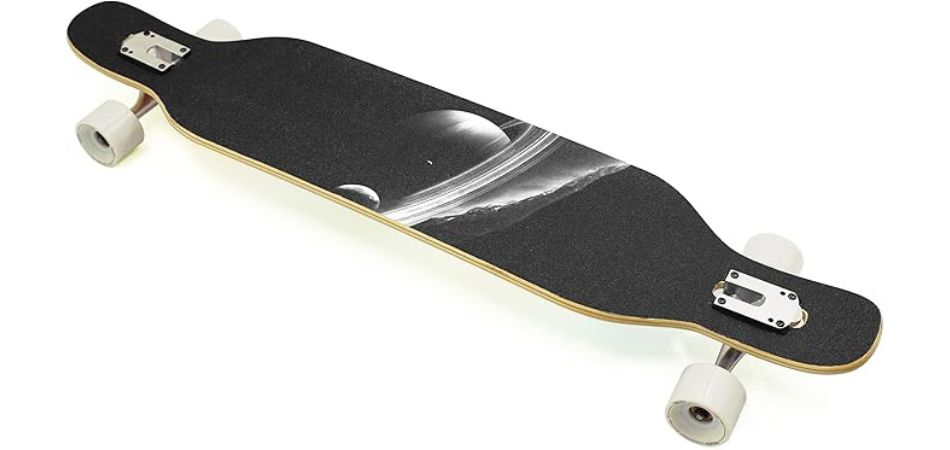
Freeride Longboards
Now that we’ve explored downhill longboards, let’s dive into the exciting world of freeride longboards. These versatile boards are a favorite among riders who love to push their skills to the limit.
Versatile Boards for Tricks and Slides
Freeride longboards are designed to give you the freedom to express your creativity on the pavement. Whether you’re carving down a hill, performing slides, or executing technical tricks, these boards have got you covered. Their unique design allows you to seamlessly transition between different styles of riding, making them perfect for those who crave variety in their longboarding experience.
Customizable Setups
One of the most attractive features of freeride longboards is their customizability. You can tailor your setup to match your riding style and preferences. Here’s a breakdown of the key components you can customize:
| Component | Customization Options |
|---|---|
| Deck | Concave, length, width |
| Trucks | Width, angle, bushing durometer |
| Wheels | Durometer, size, contact patch |
| Bearings | ABEC rating, material |
This level of customization allows you to fine-tune your board for optimal performance, whether you’re focusing on speed, control, or a balance of both.
Popular Among Experienced Riders
While beginners can certainly enjoy freeride longboards, they’re particularly popular among experienced riders. Here’s why:
- Advanced techniques: Freeride boards excel at slides and technical maneuvers that require skill and practice.
- Versatility: Experienced riders appreciate the ability to switch between different riding styles.
- Customization: Seasoned longboarders often have specific preferences that freeride boards can accommodate.
- Challenge: These boards offer a constant opportunity for skill improvement and pushing personal limits.
Key Features for Optimal Performance
To get the most out of your freeride longboard, look for these essential features:
- Symmetrical shape: Allows for easy switch riding and 180-degree slides.
- Medium flex: Provides a balance between stability and responsiveness.
- Wheel wells: Prevent wheel bite during deep carves and slides.
- Durable construction: Withstands the wear and tear of frequent sliding and tricks.
By understanding these key features, you can choose a freeride longboard that matches your riding style and helps you progress in your skills.
As you can see, freeride longboards offer a thrilling combination of versatility, customization, and performance. Whether you’re an experienced rider looking to push your limits or an intermediate longboarder ready to take your skills to the next level, a freeride longboard might be just what you need to elevate your riding experience. Next, we’ll explore carving longboards, which offer a different but equally exciting riding experience.
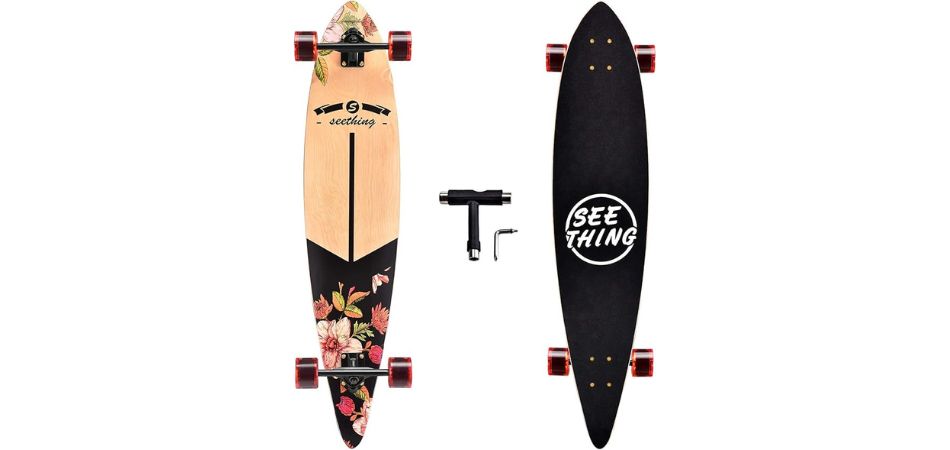
Carving Longboards
Now that we’ve explored various longboard types, let’s dive into the world of carving longboards. These specialized boards are designed to give you the ultimate surfing-like experience on land.
Designed for Fluid Turns and Maneuvers
Carving longboards are engineered to provide smooth, flowing turns that mimic the graceful movements of surfing. Their unique design allows you to carve effortlessly through curves and bends, making them perfect for riders who crave a dynamic and expressive riding style.
Key features of carving longboards include:
- Wider decks for increased stability
- Concave shape for better foot grip
- Flexible construction for enhanced responsiveness
These features work together to give you the perfect platform for executing fluid turns and sweeping maneuvers. Whether you’re weaving through a crowded sidewalk or carving up a gentle hill, these boards offer an unparalleled riding experience.
Responsive Trucks for Enhanced Control
One of the most crucial components of a carving longboard is its trucks. Carving longboards typically feature:
- Reverse kingpin (RKP) trucks
- Wider hangers for increased stability
- Softer bushings for improved turning
These responsive trucks allow you to initiate turns with minimal effort, giving you precise control over your board’s movements. The table below compares standard trucks to carving-specific trucks:
| Feature | Standard Trucks | Carving Trucks |
|---|---|---|
| Kingpin | Traditional | Reverse |
| Hanger Width | Narrow | Wide |
| Bushing Durometer | Higher (harder) | Lower (softer) |
| Turn Initiation | Requires more effort | Responsive, easier turns |
Ideal for Emulating Surfing on Land
If you’ve ever dreamed of catching waves but live far from the coast, carving longboards offer the next best thing. These boards allow you to:
- Simulate the fluid motions of surfing
- Practice balance and weight distribution
- Experience the thrill of carving without water
The combination of a flexible deck, responsive trucks, and large, soft wheels creates a riding experience that closely mimics the feel of surfing. You can practice your surf-style turns, cutbacks, and even cross-stepping on your carving longboard.
To get the most out of your carving longboard, try these techniques:
- Lean into your turns to initiate carves
- Use your arms for balance and style
- Experiment with foot placement to find your sweet spot
With practice, you’ll find yourself flowing through turns and carves with the grace and style of a seasoned surfer. Whether you’re cruising down a gentle slope or carving up a parking lot, your carving longboard will provide endless opportunities for creativity and expression.
As we move forward, we’ll explore another exciting longboard style that takes fluid movement to the next level – dancing longboards.
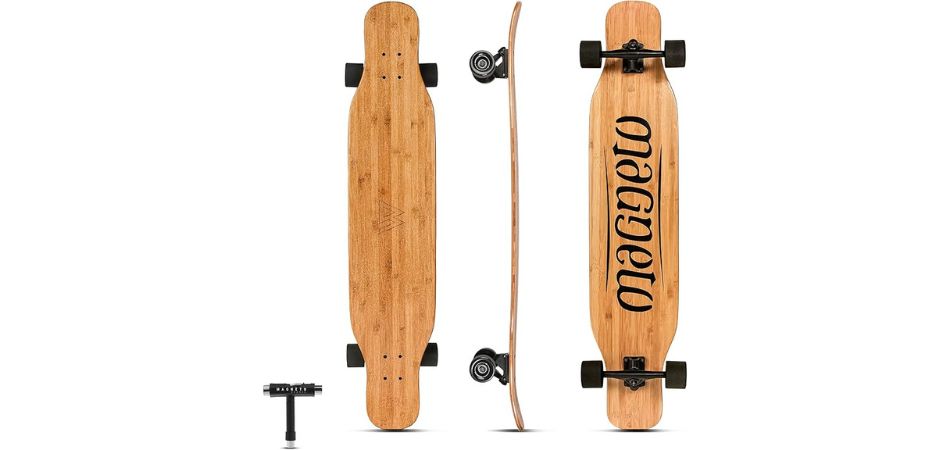
Dancing Longboards
As we explore the various types of longboards, it’s time to dive into one of the most expressive and artistic forms: dancing longboards. These unique boards allow riders to showcase their creativity and style through fluid movements and intricate footwork.
Extra-long decks for footwork and tricks
Dancing longboards are characterized by their extra-long decks, typically ranging from 42 to 50 inches in length. This extended platform provides ample space for you to perform a wide array of tricks and footwork maneuvers. The generous deck size allows you to:
- Cross-step from nose to tail
- Execute pirouettes and spins
- Perform Peter Pans and other complex steps
The additional length also contributes to enhanced stability, giving you more confidence as you practice and perfect your moves.
Lightweight construction for easier handling
Despite their larger size, dancing longboards are designed with lightweight materials to ensure ease of handling. This feature is crucial for:
- Quick direction changes
- Smooth transitions between tricks
- Reduced fatigue during extended sessions
Manufacturers often use materials like bamboo or maple for the deck, combined with lightweight trucks and wheels, to achieve the perfect balance between durability and maneuverability.
Popular in longboard freestyle competitions
Dancing longboards have gained significant popularity in freestyle competitions, where riders showcase their skills and creativity. These events typically involve:
| Competition Element | Description |
|---|---|
| Choreographed routines | Riders perform pre-planned sequences of tricks and footwork |
| Improvised performances | Spontaneous displays of skill and style |
| Technical difficulty | Judges evaluate the complexity of executed moves |
| Flow and creativity | Emphasis on smooth transitions and unique combinations |
By participating in these competitions, you can push your limits, learn from other riders, and become part of a vibrant community of longboard dancers.
Artistic expression on wheels
Dancing longboards offer you a unique platform for self-expression. As you glide along the pavement, you can:
- Develop your own signature style
- Combine dance moves with longboarding techniques
- Synchronize your movements with music
- Create visually stunning performances
This artistic aspect of longboard dancing sets it apart from other disciplines, allowing you to blend athleticism with creativity in a truly captivating way.
As you explore the world of dancing longboards, you’ll discover a perfect fusion of sport and art. Whether you’re looking to compete or simply express yourself on wheels, these boards offer an exciting and creative outlet for riders of all levels. With their extra-long decks, lightweight construction, and emphasis on artistic expression, dancing longboards open up a world of possibilities for those seeking a unique and dynamic riding experience.

Electric Longboards
Electric longboards represent the cutting-edge fusion of traditional skateboarding and modern technology. As you explore the world of longboarding, you’ll find that these innovative boards offer a unique riding experience that combines convenience, power, and eco-friendliness.
Motor-powered for effortless commuting
You’ll appreciate the ease of commuting with an electric longboard. The built-in motor does the hard work for you, allowing you to glide effortlessly through city streets or campus pathways. Whether you’re running late for a meeting or simply want to enjoy a leisurely ride, the motor-powered assistance ensures you arrive at your destination without breaking a sweat.
Range and speed capabilities
When considering an electric longboard, you’ll want to pay attention to its range and speed capabilities. These factors can significantly impact your riding experience:
| Feature | Entry-Level | Mid-Range | High-End |
|---|---|---|---|
| Range | 10-15 miles | 20-25 miles | 30+ miles |
| Top Speed | 15-18 mph | 20-25 mph | 25-30+ mph |
| Charge Time | 2-3 hours | 3-4 hours | 4-5 hours |
Remember, your actual range and speed may vary depending on factors such as rider weight, terrain, and riding style.
Eco-friendly transportation option
By choosing an electric longboard, you’re opting for a more environmentally friendly mode of transportation. Here’s how you contribute to a greener planet:
- Reduced carbon emissions compared to cars or motorcycles
- No need for fossil fuels
- Minimal noise pollution
- Compact size reduces urban congestion
Your decision to ride an electric longboard helps decrease your carbon footprint while still enjoying an efficient and fun way to get around.
Maintenance and charging considerations
To keep your electric longboard in top condition, you’ll need to pay attention to maintenance and charging:
- Regular cleaning: Wipe down your board after each ride to prevent dirt buildup.
- Battery care: Avoid completely draining the battery and store it at around 50% charge when not in use.
- Tire pressure: If your board has pneumatic tires, check and maintain proper pressure.
- Belt tension: For belt-driven models, regularly check and adjust the belt tension.
- Software updates: Keep your board’s firmware up to date for optimal performance.
Charging your electric longboard is straightforward, but you should follow best practices:
- Use only the charger provided by the manufacturer
- Charge in a cool, dry place away from flammable materials
- Avoid overcharging by unplugging once the battery is full
- Never charge an overheated battery; allow it to cool first
By following these maintenance and charging guidelines, you’ll ensure your electric longboard remains reliable and safe for years to come.
Now that you understand the benefits and considerations of electric longboards, you’re well-equipped to decide if this modern twist on longboarding is right for you. Whether you’re looking for an efficient commuting solution or a fun way to explore your surroundings, an electric longboard offers a unique and exciting riding experience.
Conclusion
Longboarding offers a diverse range of experiences, from leisurely cruising to adrenaline-pumping downhill rides. As you’ve discovered, there’s a longboard for every style and preference. Whether you’re drawn to the stability of cruising boards, the speed of downhill decks, the versatility of freeride setups, the fluid movements of carving boards, the artistic expression of dancing longboards, or the convenience of electric models, you’re sure to find a perfect match.
Remember, the key to enjoying longboarding is choosing the right board for your needs and skill level. Take time to consider your riding goals and preferences before making a decision. With the right longboard, you’ll unlock a world of excitement, freedom, and endless possibilities on wheels. So grab your board, hit the streets, and embrace the unique thrill that only longboarding can provide!
FAQ’s
Are there different types of longboards?
Yes, there are several different types of longboards, each designed for specific riding styles and preferences. Some of the most common types include:
Cruiser longboards: Ideal for casual cruising and commuting, these boards are typically wider and shorter for stability and maneuverability
Pintail longboards: Known for their pointed nose and tail, pintails are excellent for carving turns and cruising down hills.
Kicktail longboards: Similar to pintails but with a slightly raised tail, kicktails allow for easier maneuvering and popping tricks.
Downhill longboards: Designed for high-speed downhill riding, these boards have a longer wheelbase and are often made with stronger materials.
Freestyle longboards: Versatile boards for a variety of tricks and maneuvers, freestyle longboards typically have a symmetrical shape.
What is the difference between a pintail and a drop through longboard?
The main difference between pintail and drop-through longboards lies in their truck mounting positions. Pintail longboards have the trucks mounted on top of the deck, while drop-through longboards have the trucks mounted through the deck itself. This affects their stability, maneuverability, and overall riding experience.
What is the easiest type of longboard to learn?
For beginners, a cruiser longboard is often considered the easiest to learn. They are typically shorter and wider, making them more stable and easier to balance on. Additionally, cruiser longboards have softer wheels, which provide a smoother ride and are less likely to cause falls.
What’s the difference between a cruiser and a pintail longboard?
Cruisers and pintails are both types of longboards, but they have key differences.
Cruisers are shorter, narrower, and have a rounded nose and tail, making them more maneuverable for urban environments. Pintails are longer, wider, and have a pointed tail, providing stability and control for downhill riding and cruising.

